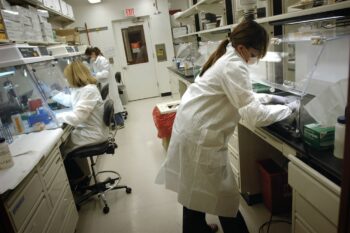By Bruce Bickel and Stan Jantz —

Beginning in 1953, scientists discovered the genetic structure deep inside the nucleus of our cells. This genetic material is referred to as DNA, an abbreviation for deoxyribonucleic acid. The discovery of the double-helix structure of the DNA molecule was only the beginning. Embedded within the molecule is an actual code.
DNA coding is similar to computer program coding. Computer programming uses a series of ones and zeros. These two digits repeat in an arranged series called a binary code. The sequencing and ordering constitutes the specific code. The DNA molecule contains four chemicals, which are abbreviated with the letters A, T, G and C. The sequence and order of these four chemicals create the code using the four letters like the ones and zeros in binary coding. The sequences of these chemicals provide the instructions necessary to assemble complex protein molecules that, in turn, help form structures as diverse as eyes, kidneys, and feet.
Now, prepare yourself to be amazed as you comprehend the magnitude of this:
Within the tiny space where the DNA molecule resides in every cell of your body, the DNA code is 3.1 billion letters long. (That’s a lot of repeating A, T, G and C’s.) If you were to read the code for the DNA information in a single cell—reading at the rate of three letters per second—it would take thirty-one years, assuming you read continually every day, for twenty-four hours a day.
The amount of information in human DNA is roughly equivalent to twelve sets of The Encyclopedia Britannica—which would be an incredible 384 volumes’ worth of detailed information that would fill forty-eight feet of library shelves.
The actual thickness of the DNA molecule is only two millionths of a millimeter. According to biologist Michael Denton, a teaspoon of DNA could contain all the information needed to build the proteins for all the information needed to build the proteins for all the species of organisms that have ever lived on the earth, and “there would still be enough room left for all the information in every book ever written.”
Each person’s DNA code is unique. Yet 99.9 percent of our DNA is similar to the genetic makeup of everyone else. That means that 0.1 percent difference in the sequencing in those 3.1 billion letters embedded in your cells is what makes you uniquely you.
From a spiritual perspective, the significance of this DNA research is twofold. First, in the debate over origins, it weighs very heavily in favor of an intelligent Designer. God is revealing Himself to the world, and it is becoming obvious to everyone.
At a ceremony acknowledging the accomplishments of the Human Genome Project, President Bill Clinton said, “Today we are learning the language in which God created life. We are gaining ever more awe for the complexity, the beauty, the wonder of God’s most divine and sacred gift.” Dr. Francis Collins, the Director of the Human Genome Project, responded; “It is humbling for me and awe inspiring to realize that we have caught the first glimpse of our own instruction book, previously known only to God.”
But second, and perhaps more importantly, DNA research reaches every individual at a personal level. It reveals God’s involvement in our individual lives. Our amazing God wrote a unique, personal genetic code for each of us.
If you want to know more about a personal relationship with God, go here
From “God is Amazing” by Bruce Bickel and Stan Jantz, published by Barbour Publishing Inc. Used by Permission.



